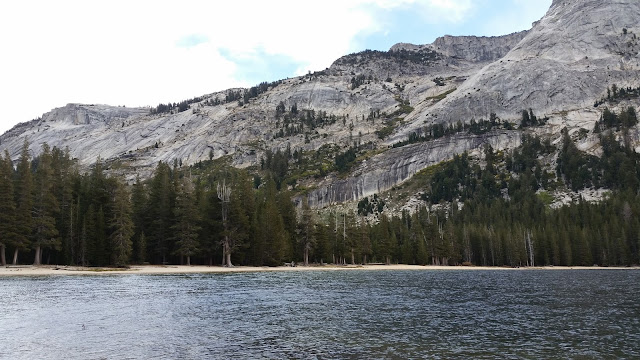Visited on 10/12/2017 while traveling to Avila Beach to join Jeff and the dogs on a weekend camping trip on the beach. Lake Nacimiento is an 18-mile long
lake on the Nacimiento River in northern San Luis Obispo County, California.
The lake contains many arms including Snake Creek and Dip Creek, nearer the
dam, and the central Las Tablas and Franklin Creeks. Because of the dragon-like
shape created by the positions of these arms, it is sometimes referred to as
Dragon Lake. The lake can fill quickly in the winter from river surges
resulting from downpours upstream in the Santa Lucia Range so the level is not
usually allowed to capacity until May 1 of each year.
Lake Nacimiento has a low fish
population due to the high levels of mercury present in the lake, due to runoff
from the closed Klau and Buena Vista Mercury Mines, south of the lake. Only
a few fisherman manage to catch fish. Consumption of bass, crappies, carps, and
catfish from the lake is dangerous, but blue gill and sucker fish may be eaten
only once per week safely. The lake is unique among California reservoirs in
that it contains, among other species, introduced white bass, which thrive in
the lake and spawn in the river and inflowing creeks in spring. In fact, the
world fly fishing record for a white bass was broken in 1981 at Lake
Nacimiento. The fish was caught by Cory Wells, a member of the world famous
musical group, Three Dog Night. The record stood for over 27 years. Lake
Nacimiento can also produce power from a turbine at the base of the dam.
Lake Nacimiento is also a haven
for watersport enthusiasts. The lake provides ample room for waterskiing,
wakeboarding, jetskiing, wakesurfing, and other water-related activities.
The lake was originally
designed for irrigation water and flood control as well as recreation.
Nacimiento Dam, a 210-foot earthfilled dam, forms the lake. The dam was
built by the Monterey County Water Authority under Monterey County District
Engineer Loran Bunte Jr, which completed construction in 1956. The water
authority uses the lake to recharge its groundwater. Even though the lake is
entirely inside San Luis Obispo County, the waters are patrolled by the
Monterey County Parks Department under a joint powers agreement with San Luis
Obispo County. The Monterey County Parks Department’s primary jurisdiction is
the lake waters, up to the high water mark and the resort area. The San Luis
Obispo County Sheriff’s Office does have a boat at the lake for access to the
back country around the lake. Also, they have been known to write tickets on
the water. Lake Nacimiento has a capacity of 377,000 acre feet. The lake is near the city of Paso Robles. The lake is also the home of two
residential housing developments, which lie on the lake's shore; Heritage Ranch
and Oak Shores. There are several smaller (10-40 house) private subdivisions on
the south west side of the lake. These houses were affected by the Chimney
Fire in August 2016. Except for the resort area near the dam, most of the
property around the lake is private. Overnight camping on the lake, outside of
the resort, is not allowed. Also, you are considered trespassing if you set up
or venture on land above the high water mark.
The lake was developed and paid
for by Monterey County. However San Luis Obispo County retained the rights to
17,500 acre feet of water per year. This was not requested by San Luis Obispo
County until the mid-2000s. In October 2007, construction started on a pipeline
to bring water from the lake to Paso Robles, Templeton, Atascadero, and San
Luis Obispo. During construction, three people were killed—one run over by a
dump truck, and two drowned when an excavator hit an unrelated water pipeline
which flooded a section of water project pipe under construction. The project
went online in January 2011.
The Lake's dam was shut down
during 2014 due to damage that occurred to one of the turbines, and as a result
the neighboring Lake San Antonio was emptied to critical levels to supply the
Salinas Valley with groundwater. The Lakes levels have dropped significantly
due to the recent drought conditions in California.

















































